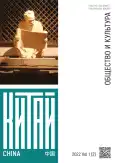Мировидение китайских династий: духовная преемственность и разрыв в девизаx правлений императоров
- Авторы: Деопик Д.В.1,2, Ганшин Б.К.1,2
-
Учреждения:
- Институт cтран Азии и Африки Московского государственного университета
- Институт Китая и современной Азии Российской академии наук
- Выпуск: Том 1, № 2 (2022)
- Страницы: 7-16
- Раздел: Оригинальные исследования
- URL: https://journal-vniispk.ru/China_SC/article/view/126666
- DOI: https://doi.org/10.17816/Ch112066
- ID: 126666
Цитировать
Полный текст
Аннотация
Данная статья является второй частью большого исследования китайской духовной культуры и мировидение, продолжает исследование символической стороны истории Восточной Азии посредством анализа и классификации девизов правлений монархов. В фокусе данного исследования находится вопрос о культурной и мировоззренческой преемственности разных политических эпох китайской государственности, а также о перерывах в этой преемственности, то есть, опосредовано ставится вопрос о целостности истории Китая и его мировосприятия на протяжении почти двух тысяч лет. Этот вопрос решается через составление списка девизов правлений, разбиением девизов на определения и объекты, и рассмотрением изменений пропорций групп, на которые классифицируются девизы правлений (а также объекты и определения, из которых они состоят) основных централизованных государств Восточной Азии. Исследование показывает, что, несмотря на появление региональных вариантов традиции девизов, в общем и целом, она сохраняет преемственность от Хань до Юань. В то же время перерыв традиции происходит не в связи с завоеваниями Восточной Азии степняками и кочевниками, а как следствие ее самостоятельной эволюции внутри китайской культуры.
Ключевые слова
Полный текст
Открыть статью на сайте журналаОб авторах
Дега Витальевич Деопик
Институт cтран Азии и Африки Московского государственного университета; Институт Китая и современной Азии Российской академии наук
Email: d.v.deopik@inbox.ru
д-р ист. наук, профессор
Россия, Москва; МоскваБогдан Константинович Ганшин
Институт cтран Азии и Африки Московского государственного университета; Институт Китая и современной Азии Российской академии наук
Автор, ответственный за переписку.
Email: bganshin@gmail.com
д-р ист. наук, профессор
Россия, Москва; МоскваСписок литературы
- Деопик Д.В. Ганшин Б.К. Символы правления как источник при изучении Китая (часть 1) // Китай: общество и культура. 2022. Т. 1. № 1. С. 19–36. DOI: https://doi.org/10.17816/Ch81799
- Wang Yu-ch’uan. An Outline of The Central Government of The Former Han Dynasty // Harvard Journal of Asiatic Studies. 1949. Vol. 12. No. 1/2. P. 134–187. doi: 10.2307/2718206
- Yang C.K. Religion in Chinese Society: A Study of Contemporary Functions of Religion and Some of Their Historical Factors. Berkeley: University of California Press, 1961.
- Schafer, E.H. Chinese Reign-Names – Words or Nonsense Syllables? //Wennti Papers. 1952. Vol. 3. P. 33–40. doi: 10.1353/tan.1990.0001
- Schafer E.H. Non-translation and Functional Translation: Two Sinological Maladies // The Journal of Asian Studies. 1954. Vol. 13. No. 3. P. 251–260. doi: 10.2307/2942278
- Wright M.C. What’s in a Reign Name: The Uses of History and Philology // The Journal of Asian Studies. 1958. Vol. 18. No. 1. P. 103–106. doi: 10.2307/2941289
- Мартынов А.С. Девизы правлений китайских императоров (нянь-хао) // Материалы 12-й научной конференции Института востоковедения «Письменные памятники и проблемы истории Культуры Востока». М., 1977. С. 78–84.
- Сыма Цянь. Исторические записки (Ши цзи) / пер., коммент. А.Р. Вяткин, В.С. Таскин. М.: Восточная литература, 2003. Т. 2. 567 с. C. 277.
- Рыбаков В.М. Танская бюрократия. Ч. 1: Генезис и структура. СПб.: Петербургское Востоковедение, 2009. 512 с. С. 19–62.
- 张俊飞. 从年号看十六国政权之文化与政治取向// 江苏教育学院学报. 2007. № 1. [Чжан Цзюньфэй. Тенденции политики и культуры периода «Шестнадцати государств» в контексте символов правлений // Цзянсу цзяоюй сюэбао. 2007. № 1.]
- История Китая с древнейших времен до начала XXI века: в 10 т. Т. 3: Троецарствие, Цзинь, Южные и Северные династии, Суй, Тан (220–907). М.: Наука, 2014.
- Wechsler H.J. Offerings of Jade and Silks: Ritual and Symbol in the Legitimation of the T’ang Dynasty. New Haven (Conn.) : Yale University Press, 1985.
- Rothschild N.H. An Inquiry into Reign Era Changes under Wu Zhao, China’s only female emperor // Early Medieval China. 2006. Issue 1. P. 123–149.
- 马雪. 两宋时期帝王年号漫议. 沧桑. 2008. № 1. [Ма Сюэ. Комментарии к символам правлений китайских монархов периодов Северной и Южной Сун // Цансан. 2008. № 1.]
- 王希佳. 彰显宗教文化魅力续写中日交流新篇从日本新年号“令和” 谈起// 中国宗教. 2019. № 4. 第10頁. [Ван Сицзя. Обсуждая то, как выбор нового японского девиза правления «Рэйва» проявляет очарование религиозной культуры в новом акте, продолжающем японо-китайские контакты // Чжунго цзунцзяо. 2019. № 4. С. 10.]
Дополнительные файлы







